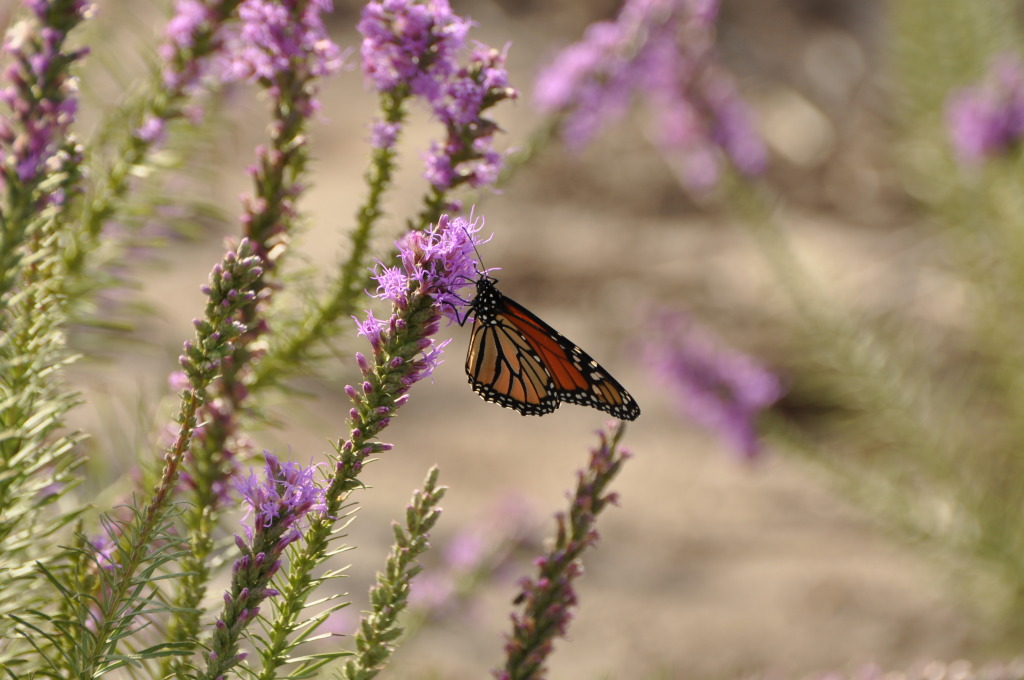First frosts lighting on Central Texas this week and reports of Monarchs and other butterflies on the wane kindle dreams of next year’s butterfly gardens and meadows. To get a jump on next year’s butterfly hostplant and nectar haven, start by collecting seeds from the wild now. November is the perfect time to gather seeds.
Last year we wrote about collecting seeds from the prolific Cowpen Daisy, one of my favorite wildflowers. Those seeds, Verbesina encelioidesm, are more scarce this year thanks to the historic Texas drought–just look at the recent picture above taken at Lucky Boy Ranch on the Llano River compared to the one below snapped last fall. Both reflect the same stretch of dirt road. What a difference a year of historic drought makes.
When it comes to seed production in the face of drought, not all plants respond the same way. “It’s a strange thing,” says George Cates, “seed cleaner extraordinaire” at Native American Seed, a company based in Junction, Texas, that focuses exclusively on native American seeds. “Certain species are very well adapted to drought conditions and actually produce MORE seed during drought,” he says.
Cates suggests that the seeds of more drought adaptive plants often seem less desirable to consumers–the poisonous purple nightshade, ornery white prickly poppy and the invasive King Ranch bluestem.

Monarch butterfly on Gayfeather at American Native Seed in Junction, TX –photo by American Native Seed
Less adaptive plants die back during the drought exposing soil to the seeds of plants that are warm season dominant, creating an opportunity for more adaptive plants’ seeds to exploit the opportunity. (One of the primary reasons wildflower seeds fail to germinate is a lack of contact with soil.) “As the ground stays crispy and cooked, other things can take advantage,” says Cates.
Plants seem to exhibit native intelligence, says Cates. “Somehow the plants know that now is a good time to make more seeds,” he explains, adding that American Native Seed’s gayfeather crop produced more abundant seeds this year than last–even though less rain fell and the native seed farm was forced by water restrictions to discontinue irrigation early in the summer.
Cates says that seeds produced in a drought likely will demonstrate longer periods of dormancy and may take longer to germinate as they await optimal conditions.
Here’s five tips from Cates on collecting wildflower seeds:
1. Try to assess whether the seed is viable. A microscope is ideal for this, but if you don’t carry one on your nature hikes, Cates recommends selecting samples from various parts of the plant and squeezing a few seeds between your fingers. Look for the hard germ core as well as softer, latent matter that surrounds and protects the seed.
2. Cut the stalk of the plant if possible and hang upside down for plant nutrients to bleed into the seeds until fully dry.
3. Don’t feel you have to clean all the fluff and chaff off the seeds. “There’s nutrients in that latent material,” says Cates. Just keep the material dry.
4. Store seeds in paper bag until completely dry. If you opt for plastic bags and store damp seed material, seeds will rot. Dry seeds=important.
5. Don’t take every last stalk of seed. Plan ahead and leave some for next year.
Good luck, and please let us know how it goes.



great article! here’s a few extra links to native seeds mentioned above:
Purple Nightshade: http://www.seedsource.com/catalog/detail.asp?product_id=3140
White Prickly Poppy: http://www.seedsource.com/catalog/detail.asp?product_id=3100
Gayfeather: http://www.seedsource.com/catalog/detail.asp?product_id=1020
Cowpen Daisy: http://www.seedsource.com/catalog/detail.asp?product_id=3054
Frostweed: http://www.seedsource.com/catalog/detail.asp?product_id=3062
Thanks, Emily. Love your catalog and often use it as a reference too look up plants. Keep up the good work!